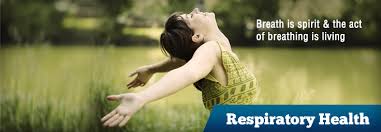Blog
Respiratory Health

The main function of the lungs is breathing. Breathing means air moves in and out of the lungs. Respiration is the act of gas exchange. On inhalation, oxygen is transferred from incoming air to red blood cells which then carry the oxygen to other cells in the body. On exhalation or breathing out, carbon dioxide gas, which is a waste product of metabolic activity in the body, is expelled.
The lungs are found in the rib cage with the top of the lungs peeping up just over the collar bones and extend down to about the 6th rib our rib cage. Lungs have lobes - the right side has three lobes (upper, middle and lower) while the left side has two lobes (upper and lower). The heart takes up the space where the left middle lobe would be if everything was perfectly symmetrical.
The primary muscle used for breathing is the diaphragm. This is a dome shaped muscle that lies beneath the rib cage and creates the separation of the chest and the abdomen. On inhalation, the diapragm flattens, the lungs increase in size by vaccum action and air is pulled into the lungs. On exhalation, the diaphragm relaxes and rebounds upwards, causing the lungs to shrink in size and air is expelled.
Adults breathe in through our noses or mouths. Babies prefer to breathe in through their noses which allows them to feed and breathe at the same time. Relative to adults, babies have larger tongues which creates some limitations for them to breathe through their mouths. However, they can absolutely breathe through the mouth if their nasal passages are blocked or if they are crying.
Breathing is controlled in the brain by the brainstem area called the medulla oblongata. What a fun name! Most breathing is unconscious however human beings have the ability to control the rate and depth of respiration. Breath practices learned through yoga can help keep the mind calm, reduce inflammation and reduce the effect of illness on the lungs.
Conditions that commonly create breathing problems:
- Colds: Inflammation and mucous secretions block the nasal passages and airways
- Allergies: create nasal congestion mostly but also congestion and inflammation in the throat and airways
- Asthma: Constriction of the airways due to congestion and inflammation; Difficult to breathe out
- Chronic Obstructive lung disease (COPD): usually due to smoke exposure; airways are distorted and lose their ability to rebound. Long term inflammation
Protecting respiratory health
- Warm fluids
- Warm air; keep the chest covered when its cold outside (our mothers were right about buttoning up!) Cold air causes the release of histamine which causes swelling and irritation of nasal passages along with the airway. Histamine is the prime chemical that creates allergic reactions.
- Wash hands to prevent the transmission of cold viruses
- Avoid crowds during cold and flu season
- Avoid cigarette smoke and/or quit smoking
- Avoid air pollutants e.g. smog
- Vaccum/dust regularly; wash sheets and blankets regularly too
- Excercise and eat a balanced diet
- Flu shot for people with asthma and chronic lung problems like emphysema, chronic bronchitis or COPD as complications from the flu can be especially serious in this group of people.
Humming the syllable "OM" can help open clogged nasal passages!
Want to learn more about Nutrition & Yoga for Respiratory Health? Join us at Whole Yoga & Wellness for an interesting workshop Saturday, January 13th from 10:30-11:30am. Learn more and register at www.wholekidspediatrics.com/yoga-and-wellness. You can download the free ebook, The Wholistic Medicine Cabinet by entering your email, Entering your email also gets you a one time 25% discount on any class/workshop. You could use the discount on for the upcoming workshop!
